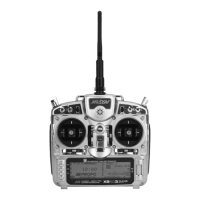Withallradioinstallations,theonboardpowersystem
must provide adequate power without interruption to the
receiver even when the system is fully loaded (servos at
maximumflightloads).Thisbecomesespeciallycritical
withgiant-scalemodelsthatutilizemultiplehigh-torque/
high-current servos. Inadequate power systems that do
not provide the necessary minimum voltage to the receiver
during flight loads are the number one cause of in-flight
failures. Some of the power system components that affect
theabilitytoproperlydeliveradequatepowerinclude:the
selected receiver battery pack (number of cells, capacity,
cell type, state of charge), switch harness, battery leads,
regulator (if used), power bus (if used).
WhiletheR921receivers’minimumoperationalvoltageis
3.5-volts, you should test the system per the guidelines
belowtoaminimumacceptablevoltageof4.8-volts
duringgroundtesting.Thisprovidesheadroomto
compensate for battery discharging or if the actual flight
loads are greater than the ground test loads.
Recommended Power System Guidelines
1. Whensettinguplargeorcomplexaircraftwithmultiple
high-torque servos, you should use a current and
voltmeter(Hangar9HAN172).Plugthevoltmeterinan
open channel port in the receiver and with the system
on, load the control surfaces (apply pressure with your
hand)whilemonitoringthevoltageatthereceiver.The
voltage should remain above
4.8voltsevenwhenallservosareheavilyloaded.
Note:TheoptionalFlightLoghasabuilt-in
voltmeter that can perform this test.
2. Withthecurrentmeterinlinewiththereceiverbattery
lead, load the control surfaces (apply pressure
withyourhand)whilemonitoringthecurrent.The
maximum continuous recommended current for a
singleheavy-dutyservo/batteryleadisthreeamps
while short duration current spikes of up to five amps
are acceptable. Consequently, if your system draws
more than three amps continuous or five amps for
short durations, a single battery pack with a single
switch harness plugged into the receiver for power is
inadequate.Youshouldusemultiplepacksofthesame
capacity with multiple switches and multiple leads
plugged into the receiver.
3. If using a regulator, it’s important that the above tests
are done for an extended period of 5 minutes. Currents
passing through a regulator generate heat, and this
heat causes the regulator to increase resistance, which
in turn causes even more heat to build up (thermal
runaway).Whilearegulatormayprovideadequate
power for a short duration, you should test its ability
over time as the regulator may not be able to maintain
voltage at significant power levels.
4. For really large aircraft or complex models (e.g. 35%
and larger or jets), multiple battery packs with multiple
switch harnesses are necessary. In many cases, one
ofthecommerciallyavailablepowerboxes/busses
is recommended. No matter what power system you
choose,alwayscarryouttest#1abovemakingsurethe
receiverisconstantlyprovidedwith4.8voltsormore
under all conditions.
5. ThelatestgenerationofNickel-MetalHydridebatteries
incorporate a new chemistry mandated to be more
environmentallyfriendly.Thesebatteries,when
charged with peak detection fast chargers, have
tendencies to false peak (not fully charge) repeatedly.
TheseincludeallbrandsofNi-MHbatteries.Ifusing
Ni-MH packs be especially cautious when charging,
make absolutely sure that the battery is fully
charged.Youshoulduseachargerthatcandisplay
total charge capacity. Note the number of mAh put into
a discharged pack to verify it has reached capacity.
Receiver Power System Requirements
All preprogrammed data is protected by a flash
memory that guards against memory loss .
Flash Memory
Battery Alarm and Display
Whenthetransmittervoltagedropsbelow9.0-voltsDC,
thedisplayflashes“BATTLOW”andanalarmsounds.
If you are flying when this occurs, land immediately.
Tips on Using 2.4GHz Systems
WhileyourDSM-equipped2.4GHzsystemisintuitiveto
operate, functioning nearly identically to 72MHz systems,
following are a few common questions from customers.
1. Q:WhichdoIturnonfirst,thetransmitterorthe
receiver?
A:Ifthereceiveristurnedonfirst,allservosexcept
for the throttle will be driven to their preset fail-safe
positions set during binding. At this time, the throttle
channel doesn’t put out a pulse position preventing
the arming of electronic speed controllers or, in the
case of an engine-powered aircraft, the throttle servo
remainsinitscurrentposition.Whenthetransmitteris
then turned on, the transmitter scans the 2.4GHz band
andacquirestwoopenchannels.Thenthereceiverthat
was previously bound to the transmitter scans the band
and finds the GUID (Globally Unique Identifier code)
storedduringbinding.Thesystemthenconnectsand
operates normally.
If the transmitter is turned on first, the transmitter
scans the 2.4GHz band and acquires two open
channels.Whenthereceiveristhenturnedonfora
short period (the time it takes to connect), all servos
except for the throttle are driven to their preset
fail-safe positions while the throttle has no output
pulse.Thereceiverscansthe2.4GHz band looking
for the previously stored GUID; and when it locates
the specific GUID code and confirms uncorrupted
repeatable packet information the system connects and
normaloperationtakesplace.Typicallythistakes2to
6seconds.
2. Q:Sometimesthesystemtakeslongertoconnectand
sometimes it doesn’t connect at all?
A:Inorderforthesystemtoconnect(afterthereceiver
is bound) the receiver must receive a large number of
continuous (one after the other) uninterrupted perfect
packetsfromthetransmitter.Thisprocessispurposely
critical of the environment, ensuring that it’s safe to
fly when the system does connect. If the transmitter
is too close to the receiver (less than 4 feet) or if
the transmitter is located near metal objects (metal
transmitter case, the bed of a truck, the top of a metal
work bench, etc.) connection will take longer, and in
some cases, connection will not occur as the system
is receiving reflected 2.4GHz energy from itself and is
interpreting this as unfriendly noise. Moving the system
away from metal objects or moving the transmitter away
from the receiver and powering the system up again will
causeaconnectiontooccur.Thisonlyhappensduring
the initial connection. Once connected, the system is
locked-in and, should a loss of signal occur (fail-safe),
the system connects immediately (4ms) when signal is
regained.

